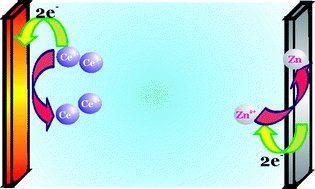The charging of an undivided cerium–zinc redox battery by various current waveforms some of which mimic the output of renewable energy (solar, wind, tidal, biofuel burning) to electricity transducers is considered in this work, where the battery operates through diffusion-only conditions, and is discharged galvanostatically. Under reasonable assumption, the mathematical model developed enables the observation that the performance characteristic of the cells charged with a constant power input differentiates between the various current–charge waveforms, with cell geometry and electrode kinetics playing subtle, but significant, roles; in particular, high efficiency is observed for sunlight-charged batteries which are thin and suffer no corrosion of the sacrificial electrode, and which have already experienced a charge–discharge cycle. The performance characteristics of the systems are interpreted in the light of consequences for smart grid realisation, and indicate that, for a constant power input, the most matched renewable is biofuel burning with a current output that linearly increases with time.

You have access to this article
 Please wait while we load your content...
Something went wrong. Try again?
Please wait while we load your content...
Something went wrong. Try again?


 Please wait while we load your content...
Please wait while we load your content...